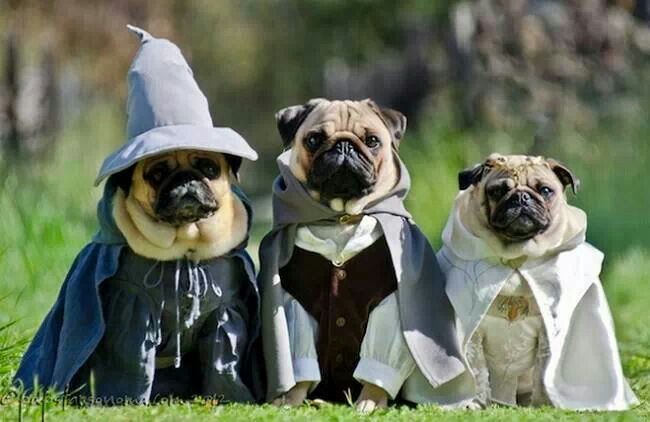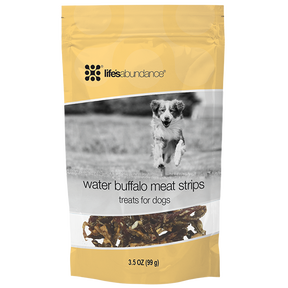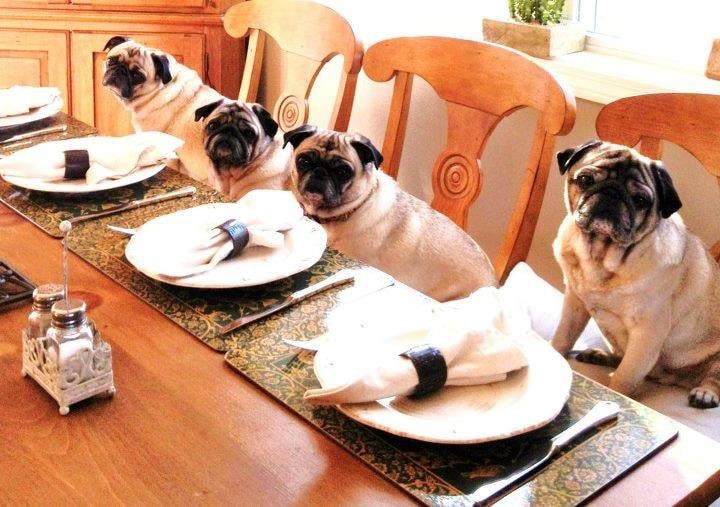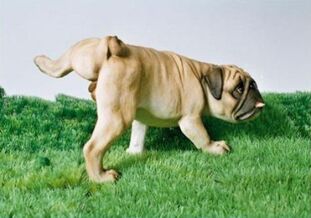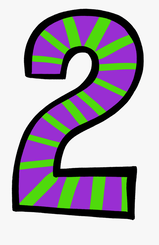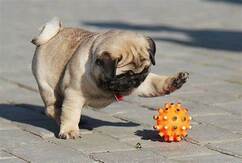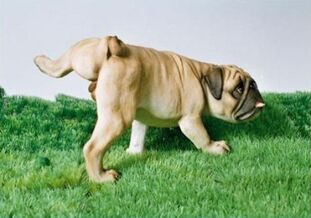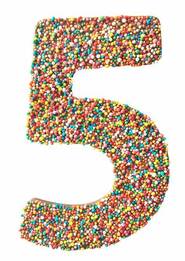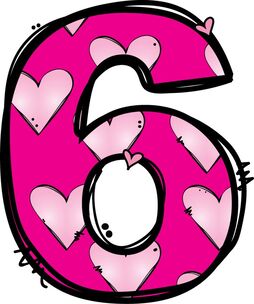Your Puppy's Daily Schedule
This is a description of a typical day your puppy has experienced of late. While the exact times might vary some depending upon work and other scheduling issues (7 AM versus 8 AM etc.), just remember that the puppy's bladder has a definite time restraint .... and that clock is consistent despite the human's daily schedule. Honestly, the more consistent you are with a schedule, the healthier and happier your pup will be and it's truly the only way to master house training. So, perhaps it's helpful to think like a Hobbit when setting up your puppy's schedule!

. . . . your puppy will only need 3-4 meals each day (plus additional treats with training).
But, for fun, let's organize the day like a Hobbit, with 7 blocks of time . . . . . Your puppy needs access to water throughout the day. We love rabbit feeders and our pugs all have rabbit feeders IN THEIR CRATES.
- 1st Thing AM: Potty-Breakfast-Potty
- Mid-morning: Play-Train-Potty?-Nap
- Noon: Potty-Lunch-Potty
- Mid-afternoon: Play-Train-Potty?-Nap
- Dinner: Potty-Dinner-Potty
- Evening: Witching Hour ;) Play-Train-Potty-Snuggle
- Bedtime: Potty-Sleep (if not using an X-pen/litter box set-up with younger pups, you will need to set an alarm for a middle of the night potty .... no more than 4 hours in a crate IF dinner/water was early enough).
Your puppy is litterbox trained by the time it is 4 weeks old. By 12 weeks he or she has started work on crate training (up to a few hours max). Crates are a fun place for your puppy. Keep it that way to make your life easy for the years to come!
Always lure them in with a treat and toy! Make it fun and positive. We played "crate games" quite often and even had meals in crates
Always lure them in with a treat and toy! Make it fun and positive. We played "crate games" quite often and even had meals in crates
Your puppy also knows how to go potty outside but, because of Parvo threats, we do not go into grassy area or dirt until after the final vaccinations (which will be done by you once the puppy is living with you). Also, your puppy's bladder is still small so it can not "hold it" for more than a few hours at a time.
So, your puppy is on his way to mastering house training but, due to age and health risks, still has more work to do. It won't happen overnight but adhering to a schedule will yield the greatest success.
- Your puppy needs access to fresh water at all times.
- Your puppy will need to "go potty" after sleeping (even naps), eating, or playing.
- Always treat when and PRAISE when your puppy goes potty outside.
- Have treats with you at all times.
- Use the same door (carry pup out if crate training so it will not have an accident en route).
- Go to the same spot in the yard.
- Stand quietly and wait until they are ready, and as they commence, give a voice command or signal to “go potty” or “do your business.” Then wait for the results. Have a party and PRAISE, PRAISE, PRAISE if your puppy goes potty. Say "good girl/boy", treat, and play with them a bit before rushing back inside. Have a party!
- You can even praise/treat when they go potty in the litter box, too! boy/girl!” then give the pup a yummy treat. Your puppy needs to understand that "going potty" in the proper spot(s) will bring lots of love, attention, (and, of course, treats!)
- If your pup doesn’t go when you’re outside, you may have to take them inside and come back out again in a few minutes. Even they do go, they may need to head back out very soon, so stay vigilant.
- NEVER PUNISH YOUR PUPPY if there is an accident indoors. If you catch them in the act say "uh-oh" to get their attention. Once they stop, gently and immediately pick them up and take them outside. Praise them lavishly when they finish up. (Clean-up soils inside with Simple Solution or some other enzyme odor-neutralizing solution).
- If you choose to crate train (versus play pen with litterbox) remember that your puppy can not 'hold it" more than a few hours. If you’re unsure about how long your puppy can hold it, use the month-plus-one rule. Take the age of your puppy in months and add one, and that is the maximum number of hours that your puppy should be able to comfortably hold it between potty breaks. A 3-month-old puppy plus one equals 4 hours that they should be able to stay in the crate without a mess.
But, by carefully scheduling their meals, playtime, training, treats, potty training will be much easier. Just remember, it won't happen overnight, so be patient. Try to laugh it off when accidents happen. Pugs learn best when everything is fun and a game. House-training is a "game" you don't want to lose to your puppy, so keep it a game! Pugs shut down with harsh punishment. That's a sure way for the human to lose the game!
1. 1st Thing in the Morning = POTTY OUTSIDE: Each day will begin the same for you and your puppy. As soon as you wake up, take your puppy out of the crate and outside to "go potty". Don't stop to make coffee, check emails, brush teeth etc. .... 1st thing. (NOTE: your puppy's bladder will be too small to make it through an entire night of sleep so, in the beginning .... if you are not using an X-pen setup with a litterbox and paper pellets ..... you will need to set an alarm for a middle-of-the-night-potty and be very careful about feeding times.)
Remember ....Avoid Parvo! Until at least a week after 3rd round of vaccinations, always take puppy outside to a Cloroxed and water pressured area which is free from Parvo ... we have a concrete area which is contained with X-pens for younger puppies and we avoid dirt and areas where Parvo might be lurking.
ALWAYS GIVE THE PUPPY A TREAT AFTER "potty outside" (add verbal cue ... "go potty" "or whatever you choose) and PRAISE, PRAISE, PRAISE.
(FYI: We keep some dehydrated treats in a small decorated box which is mounted on the wall just by the door .... actually, by all the doors and inside gates .... you can also use treats to "sprinkle" on floor when you need to get through a door without puppy escaping until "Wait" is 100% mastered).
After you praise, praise, praise, and treat. Bring your puppy back inside and either let it stay with you in the kitchen as you prepare breakfast, or have an X-pen setup with bed, chew toys etc. for entertainment.
We give the puppy a small saucer of Raw Goat Milk as an "appetizer" to breakfast. You could also (instead) give a spoon of probiotic yogurt (we like Greek God's Honey Vanilla).
Prepare breakfast. If you chose to let the puppy "help" you prepare breakfast, we recommend keeping your pup on a leash, even when inside, during the initial stages of training. You need to keep eyes on your pup at all times ;) We use an X-pen area where they can wake-up, chew, play while we prepare breakfast. Kongs. Nylabones. Bully Sticks MADE IN USA! (check regularly ... throw away once they get smaller/shorter than your pinky).
We give the puppy a small saucer of Raw Goat Milk as an "appetizer" to breakfast. You could also (instead) give a spoon of probiotic yogurt (we like Greek God's Honey Vanilla).
Prepare breakfast. If you chose to let the puppy "help" you prepare breakfast, we recommend keeping your pup on a leash, even when inside, during the initial stages of training. You need to keep eyes on your pup at all times ;) We use an X-pen area where they can wake-up, chew, play while we prepare breakfast. Kongs. Nylabones. Bully Sticks MADE IN USA! (check regularly ... throw away once they get smaller/shorter than your pinky).
BREAKFAST:
Kibble + broth (a spoonful or 2 ... not too much). We recommend always adding broth (or water) to kibble. Always. Even with adults. Pugs have been known to choke on dry kibble. We use low/no sodium chicken or beef or lamb broth (we make our own by boiling a chicken thigh or neck or some chicken paws or other bones). You can also use Instant Beef Bone Broth for Dogs (thehonestkitchen.com) or these Amazon.com : Herb-Ox Low Sodium Chicken Pockets, 8 ct : Chicken Bouillon : Grocery & Gourmet Food
Kibble + broth (a spoonful or 2 ... not too much). We recommend always adding broth (or water) to kibble. Always. Even with adults. Pugs have been known to choke on dry kibble. We use low/no sodium chicken or beef or lamb broth (we make our own by boiling a chicken thigh or neck or some chicken paws or other bones). You can also use Instant Beef Bone Broth for Dogs (thehonestkitchen.com) or these Amazon.com : Herb-Ox Low Sodium Chicken Pockets, 8 ct : Chicken Bouillon : Grocery & Gourmet Food
We also add these supplements (to breakfast meal only):
Vitamin (we break into smaller chunks, or crush up into powder and sprinkle over the kibble)
Fish oil (go easy on this with younger pups ... a tiny bit or else you will end up with loose stools)
(FYI: For the older pugs we use this vitamin which has glucosamine MSM and other good things to help with joints and mobility):
Sometimes we add these antioxidant health bars or a spoonful of canned pumpkin (NOT the pie mix, but pure pumpkin).
It is a good idea to elevate the bowl to a good height to keep the pup/pug from having to bend over. You can just put a couple of bricks down or thick book or, once they're tall enough, we love this Fluff Trough : Personalized Elevated Dog & Cat Bowls (designed by a pug owner for pugs!)
TO BOWL OR NOT TO BOWL?
The great dog trainer and vet, Ian Dunbar, explained in a workshop we attended once that he ONLY feeds (even kibble!) while training. He puts the kibble into a tupperware container and dispenses throughout the day. Always training. This might be something you'd want to consider. We would do this if we didn't have so many dogs as it truly works. If you choose this route, do some easy training during breakfast and use up those kibble pieces and vitamins as much as possible, treating/feeding by hand. Load the clicker .... click and treat. Load the puppy's name (say name then treat). Do the "attention" game and anytime puppy looks into your eyes, click and treat. Work on hand target/touch, puppy push-ups, sit stay durations, bow, shake, and physically less demanding activities. Feeding by hand this way is also great for reinforcing and continuing to master "soft bite".
Pick-up the bowl of kibble after 15 minutes. If they did not eat it all, refrigerate and save for later. You can actually blend it and add goat's milk and pumpkin to make some treats if they are having a finicky day. Perhaps add a teency bit of chicken liver or cream cheese into the 'blobs' ;)
It is a good idea to elevate the bowl to a good height to keep the pup/pug from having to bend over. You can just put a couple of bricks down or thick book or, once they're tall enough, we love this Fluff Trough : Personalized Elevated Dog & Cat Bowls (designed by a pug owner for pugs!)
TO BOWL OR NOT TO BOWL?
The great dog trainer and vet, Ian Dunbar, explained in a workshop we attended once that he ONLY feeds (even kibble!) while training. He puts the kibble into a tupperware container and dispenses throughout the day. Always training. This might be something you'd want to consider. We would do this if we didn't have so many dogs as it truly works. If you choose this route, do some easy training during breakfast and use up those kibble pieces and vitamins as much as possible, treating/feeding by hand. Load the clicker .... click and treat. Load the puppy's name (say name then treat). Do the "attention" game and anytime puppy looks into your eyes, click and treat. Work on hand target/touch, puppy push-ups, sit stay durations, bow, shake, and physically less demanding activities. Feeding by hand this way is also great for reinforcing and continuing to master "soft bite".
Pick-up the bowl of kibble after 15 minutes. If they did not eat it all, refrigerate and save for later. You can actually blend it and add goat's milk and pumpkin to make some treats if they are having a finicky day. Perhaps add a teency bit of chicken liver or cream cheese into the 'blobs' ;)
POTTY BREAK #2: Puppies usually need to relieve themselves again, within a few minutes of eating, so give another potty opportunity. After this, spend some time playing and/or doing a little training with your puppy. And though everyone is busy in the morning getting ready for work or school, make time for a quick walk to give him a chance to do his business one more time before settling into play X-pen (or crate) for a mid-morning nap.
Mid-morning: Train-Potty?-Nap
Regardless of if you are putting all the breakfast in a bowl, or hand feeding/training:
After the breakfast/play/potty routine, even when we're home during the day, we let the puppies spend time in their crate or pen ... they need to allow their food to digest and need some quiet time. Crate or pen time also helps the puppy learn how to be alone when necessary. We usually give them a chew toy, favorite toy (krinkle toy etc.), bully stick etc. And we ALWAYS give a small treat and a toy when putting the puppy into a crate. Always.
Regardless of if you are putting all the breakfast in a bowl, or hand feeding/training:
After the breakfast/play/potty routine, even when we're home during the day, we let the puppies spend time in their crate or pen ... they need to allow their food to digest and need some quiet time. Crate or pen time also helps the puppy learn how to be alone when necessary. We usually give them a chew toy, favorite toy (krinkle toy etc.), bully stick etc. And we ALWAYS give a small treat and a toy when putting the puppy into a crate. Always.
It’s also impossible to know what a puppy will get into when you turn away for a moment and there needs to be a place to put him when you can’t supervise directly. If he will be home alone for more hours than he can control his bladder or bowels, you need to set up a pen with an area for him to relieve himself – or consider having a pet sitter come to take him out (but BE AWARE of the possibility of pet sitters accidentally and unknowingly bringing Parvo into your home!)
Noon: A repeat of the early morning routine – as soon as he wakes up, a trip outside.
This is a good time for playing tug, fetch, ball, frisby (nothing too hard on the puppy until their growth plates close! No jumping too high, no long walks or runs. Click here for physical activity guidelines. We suggest purchasing this poster and hanging it somewhere handy for quick and frequent reference!) Spend some time playing with and training him, so he can burn some energy.
After potty and some fun time, it's time to eat again! Yep, just like a Hobbit! This time, though, you won't be adding supplements ... just a bit of broth over the kibble. lunch (kibble again, without vitamins and supplements) .... in a bowl, or hand-feeding while easy training.
Followed by another trip outside following the meal (kibble in a bowl or from the hand ... as you choose and have time for .... but you'll get a huge bang for your buck if choose the Ian Dunbar way of food distribution! These puppies are SPONGES for the next weeks so it's a good idea to take advantage of lots of short training sessions ... just seconds or minutes each .... throughout the day before they are teenagers ;) And don’t forget one more potty break before the afternoon nap!
Mid-afternoon: When he wakes up, it’s time to go out — again. Don't forget those treats! (Again, that's why we keep them in a box nailed to the wall just by the doors). And, it's time to play and train again. Remember, train should really just be play to the puppy! Even if it's just a practice of sit, down, or spin and a quick game of fetch, what will tire your puppy out more than anything (and make him less destructive and less "bitey" and frustrated) is tiring out that brain!
If the weather is good, these short training/play sessions are great outside, so that you can then have your "Oh, I need to potty again" moment. After this 2nd potty opportunity, if you're home, the puppy can hang out with you for a while before dinner. Don't forget that idea of having the puppy wear a leash (even in the house!) if he's helping you cook dinner ;)
Dinner: Potty-Dinner-Potty
If you arrange his mealtimes around yours, it will become natural to feed him either while you’re preparing dinner or while the household is eating. But pay attention so you can take him outside as soon as he’s finished. Before the family sits down to dinner, you might give the puppy some more quiet time with a chew toy in his crate. Some folks seem to think (?) that begging at the table is bad. Honestly, we purchased a glass dining room table early in our marriage JUST SO THAT we could see their cute little faces looking up at us at all times. Lol. You can even put the puppy's kibble in a tupperware next to your dinner plate and sneak a bit down ... "puppy sit, kibble" .... "puppy down, kibble" .... and anytime puppy is manding (sitting, looking up at you and not jumping on you) capture the moment and praise and kibble! You want to teach them to be good "restaurant dogs" eventually, so ... why not take advantage of this training opportunity! (Unless the Queen of England has come a calling and you are using your fine china, of course.) When we only had 2 or 3 dogs, we trained them each to go sit on their own beds (which had their names on them) .... the beds were close by the table. Alas, those days are gone lol! Now, we have tv trays and the pugs sit all around us. We've gotten good at not noticing those eyes follow our every move. Ha.
Evening: You guessed it, ANOTHER POTTY BREAK! The early evening is a good time for lots of interaction. Beware of this time block as it is very often the "witching hour" for puppies (think young toddler ready to crash .... acting as if he had just eaten an entire bag of mini snickers bars). But if you are prepared ahead of time and initiate some play and fun training the puppy will typically settle. Again, tire out those brains! Fetch is the all time great game. Remember, the puppy needs smaller toys to be able to grab. If you play tug-of-war, watch some videos on how to properly do this so you do not damage the puppy.
In case you didn't know, pugs are great at watching the news with you BUT puppies prefer biting your pants leg during this witching hour if you ignore them. ;) And, a tip: don't forget those bully sticks if you plan to "watch" the evening news with your pup in your lap :)
While we're on the subject of sofas, don't forget those ramps! NEVER LET A PUPPY JUMP OFF OF A SOFA, RECLINER, BED. It's too high for them. Unless you want to fool with very expensive surgery and physical therapy (I never can remember how many zeros are in 10K?) then take every precaution possible to prevent them from jumping or falling before those growth plates close around 12-18 months.
Always make sure the puppy has plenty of potty opportunities right before bedtime.
In case you didn't know, pugs are great at watching the news with you BUT puppies prefer biting your pants leg during this witching hour if you ignore them. ;) And, a tip: don't forget those bully sticks if you plan to "watch" the evening news with your pup in your lap :)
While we're on the subject of sofas, don't forget those ramps! NEVER LET A PUPPY JUMP OFF OF A SOFA, RECLINER, BED. It's too high for them. Unless you want to fool with very expensive surgery and physical therapy (I never can remember how many zeros are in 10K?) then take every precaution possible to prevent them from jumping or falling before those growth plates close around 12-18 months.
Always make sure the puppy has plenty of potty opportunities right before bedtime.
Bedtime: It's really a great idea to keep the bedtime the same each night .... it will help especially with house training. Whether 8 PM or midnight, it doesn't matter, as long as it's the same each night and it becomes a routine.
Take the puppy to the crate after plenty of time for potty outside. Don't forget the treat and toy! We always have a crate bed or soft blankets in the crate for the puppy. Never force a puppy into a crate. It's always got to be a fun game! Use the treat and toy as a lure. Then sit with them a bit after closing the door and talk to them. Be nearby. We have a sound machine for the dog room (white noise) which helps with sleep and blocks out "cricket noises" or whatever might make them bark. You can use a transister radio at a super soft volume setting. Also, consider buying a cover for the crate as they love their forts.
If you choose to use a crate, don't forget that you'll be having to set the alarm for a middle-of-the-night-potty-outside!
If you use a play-pen with a litterbox, this will transition well to potty outside once your puppy's bladder can hold throughout the night.
Whatever your choice, just remember that the timing is set by your puppy's bladder!
If you place the crate in your bedroom, then you can hear the puppy stir and whimper if it needs a break. It really is better to wake-up a littler before you think the puppy will (set an alarm) so that you don't start a cycle of whine/bark/potty.
RAINY DAYS TIP: You can put an X-pen in an area of carport or garage or covered patio, line with tarps and clamp to sides of X-pen, and put wood shavings down (Aspen is better than pine or cedar) for a potty outside area on rainy days. There are also doggie umbrellas but these take a little practice getting the puppy used to them and pugs, typically, still hate the rain.
Also, remain watchful when the puppy drinks water. Treat this just like a meal, and take them out to potty soon afterward. Choosing a puppy food that digests well and avoiding feeding within two hours of bedtime will help.
If your pup doesn’t go when you’re outside, you may have to take them inside and come back out again in a few minutes. Even they do go, they may need to head back out very soon, so stay vigilant.
By scheduling meals, walks, playtime, and other activities in a daily routine, you and your pup will be on your way to success in potty training, but it won’t happen overnight, so remember to be patient.
This Boot Camp schedule won't last forever but, by establishing some sort of consistent routine from the very beginning you'll end up with a happy, well-adjusted pug, human. A few weeks now will pay off for the many years ahead.
Take the puppy to the crate after plenty of time for potty outside. Don't forget the treat and toy! We always have a crate bed or soft blankets in the crate for the puppy. Never force a puppy into a crate. It's always got to be a fun game! Use the treat and toy as a lure. Then sit with them a bit after closing the door and talk to them. Be nearby. We have a sound machine for the dog room (white noise) which helps with sleep and blocks out "cricket noises" or whatever might make them bark. You can use a transister radio at a super soft volume setting. Also, consider buying a cover for the crate as they love their forts.
If you choose to use a crate, don't forget that you'll be having to set the alarm for a middle-of-the-night-potty-outside!
If you use a play-pen with a litterbox, this will transition well to potty outside once your puppy's bladder can hold throughout the night.
Whatever your choice, just remember that the timing is set by your puppy's bladder!
If you place the crate in your bedroom, then you can hear the puppy stir and whimper if it needs a break. It really is better to wake-up a littler before you think the puppy will (set an alarm) so that you don't start a cycle of whine/bark/potty.
RAINY DAYS TIP: You can put an X-pen in an area of carport or garage or covered patio, line with tarps and clamp to sides of X-pen, and put wood shavings down (Aspen is better than pine or cedar) for a potty outside area on rainy days. There are also doggie umbrellas but these take a little practice getting the puppy used to them and pugs, typically, still hate the rain.
Also, remain watchful when the puppy drinks water. Treat this just like a meal, and take them out to potty soon afterward. Choosing a puppy food that digests well and avoiding feeding within two hours of bedtime will help.
If your pup doesn’t go when you’re outside, you may have to take them inside and come back out again in a few minutes. Even they do go, they may need to head back out very soon, so stay vigilant.
By scheduling meals, walks, playtime, and other activities in a daily routine, you and your pup will be on your way to success in potty training, but it won’t happen overnight, so remember to be patient.
This Boot Camp schedule won't last forever but, by establishing some sort of consistent routine from the very beginning you'll end up with a happy, well-adjusted pug, human. A few weeks now will pay off for the many years ahead.


